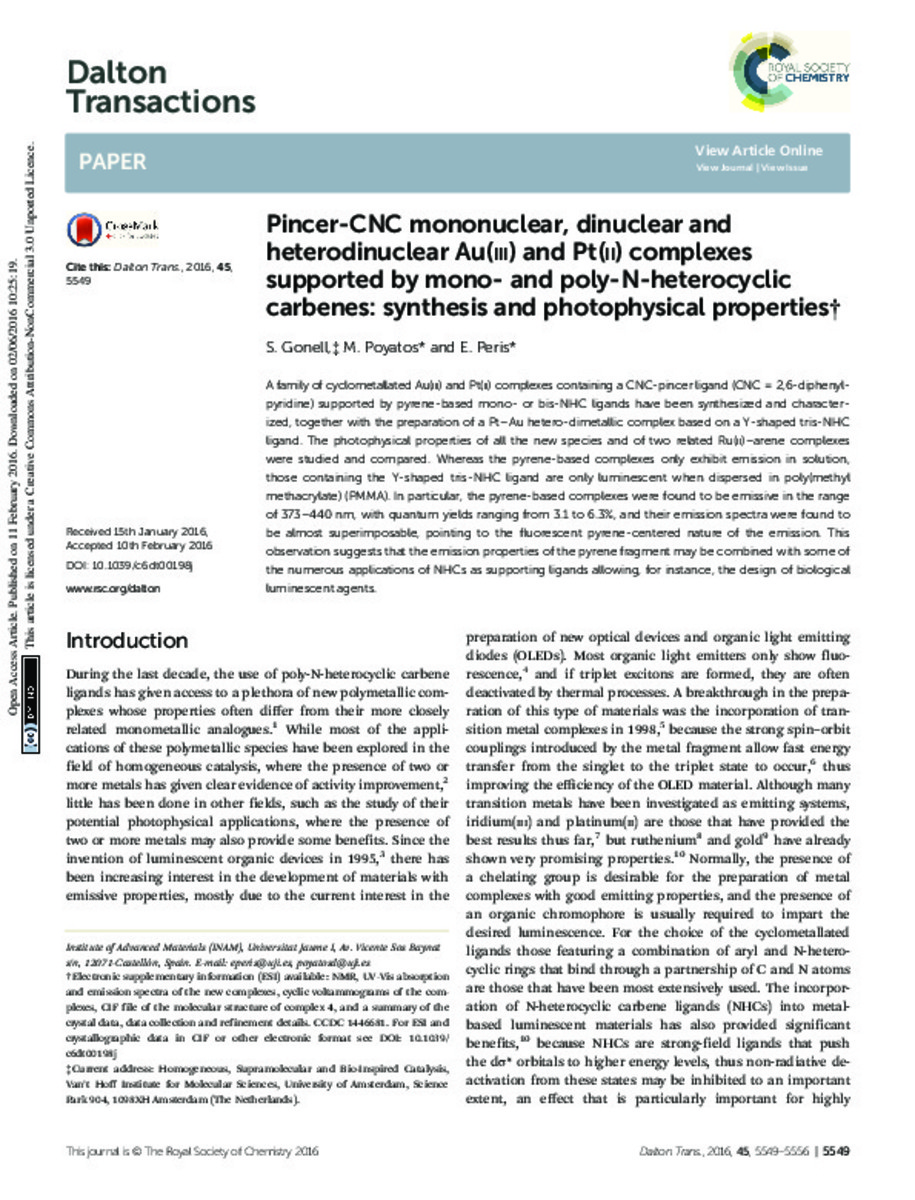Mostrar el registro sencillo del ítem
Pincer-CNC mononuclear, dinuclear and heterodinuclear Au(III) and Pt(II) complexes supported by mono- and poly-N-heterocyclic carbenes: synthesis and photophysical properties
| dc.contributor.author | Gonell, Sergio | |
| dc.contributor.author | Poyatos, Macarena | |
| dc.contributor.author | Peris, Eduardo | |
| dc.date.accessioned | 2016-06-02T09:47:40Z | |
| dc.date.available | 2016-06-02T09:47:40Z | |
| dc.date.issued | 2016 | |
| dc.identifier.citation | GONELL, S.; POYATOS, M.; PERIS, E. Pincer-CNC mononuclear, dinuclear and heterodinuclear Au (iii) and Pt (ii) complexes supported by mono-and poly-N-heterocyclic carbenes: synthesis and photophysical properties. Dalton Transactions, 2016, vol. 45, no 13, p. 5549-5556 | ca_CA |
| dc.identifier.issn | 1477-9226 | |
| dc.identifier.issn | 1477-9234 | |
| dc.identifier.uri | http://hdl.handle.net/10234/160259 | |
| dc.description.abstract | A family of cyclometallated Au(III) and Pt(II) complexes containing a CNC-pincer ligand (CNC = 2,6-diphenylpyridine) supported by pyrene-based mono- or bis-NHC ligands have been synthesized and characterized, together with the preparation of a Pt–Au hetero-dimetallic complex based on a Y-shaped tris-NHC ligand. The photophysical properties of all the new species and of two related Ru(II)–arene complexes were studied and compared. Whereas the pyrene-based complexes only exhibit emission in solution, those containing the Y-shaped tris-NHC ligand are only luminescent when dispersed in poly(methyl methacrylate) (PMMA). In particular, the pyrene-based complexes were found to be emissive in the range of 373–440 nm, with quantum yields ranging from 3.1 to 6.3%, and their emission spectra were found to be almost superimposable, pointing to the fluorescent pyrene-centered nature of the emission. This observation suggests that the emission properties of the pyrene fragment may be combined with some of the numerous applications of NHCs as supporting ligands allowing, for instance, the design of biological luminescent agents. | ca_CA |
| dc.description.sponsorShip | We gratefully acknowledge financial support from MINECO of Spain (CTQ2014-51999-P) and the Universitat Jaume I (P11B2014-02). The authors are grateful to the Serveis Centrals d’Instrumentació Científica (SCIC) of the Universitat Jaume I for providing spectroscopic and X-ray facilities. We are very grateful to Prof. M. Concepción Gimeno (CSIC-Universidad de Zaragoza) for the measurement of the photophysical properties of the samples in PMMA films. We are also grateful to Prof. Francisco Galindo (Universitat Jaume I) for his help in the emission lifetime measurements. | ca_CA |
| dc.format.extent | 8 p. | ca_CA |
| dc.format.mimetype | application/pdf | ca_CA |
| dc.language.iso | eng | ca_CA |
| dc.publisher | Royal Society of Chemistry | ca_CA |
| dc.rights | © The Royal Society of Chemistry | ca_CA |
| dc.rights | Attribution-NonCommercial 4.0 Spain | * |
| dc.rights.uri | http://creativecommons.org/licenses/by-nc/4.0/ | * |
| dc.subject | pincer-CNC mononuclear | ca_CA |
| dc.subject | photophysical properties | ca_CA |
| dc.subject | poly-N-heterocyclic carbenes | ca_CA |
| dc.subject | mono-N-heterocyclic carbenes | ca_CA |
| dc.title | Pincer-CNC mononuclear, dinuclear and heterodinuclear Au(III) and Pt(II) complexes supported by mono- and poly-N-heterocyclic carbenes: synthesis and photophysical properties | ca_CA |
| dc.type | info:eu-repo/semantics/article | ca_CA |
| dc.identifier.doi | http://dx.doi.org/10.1039/c6dt00198j | |
| dc.rights.accessRights | info:eu-repo/semantics/openAccess | ca_CA |
| dc.relation.publisherVersion | http://pubs.rsc.org/en/content/articlepdf/2016/DT/C6DT00198J | ca_CA |
Ficheros en el ítem
Este ítem aparece en la(s) siguiente(s) colección(ones)
-
QUIO_Articles [692]
Articles de publicacions periòdiques








